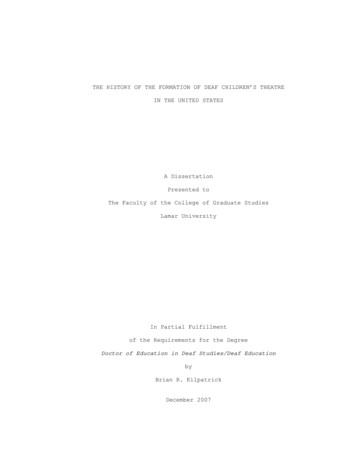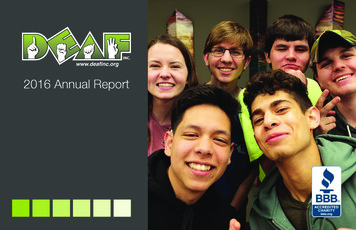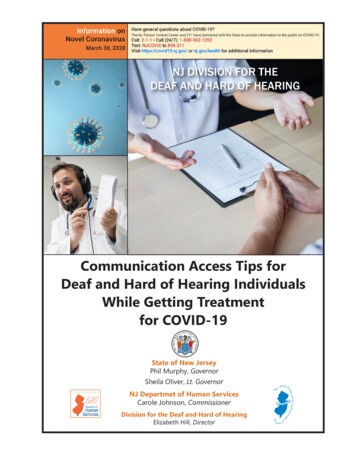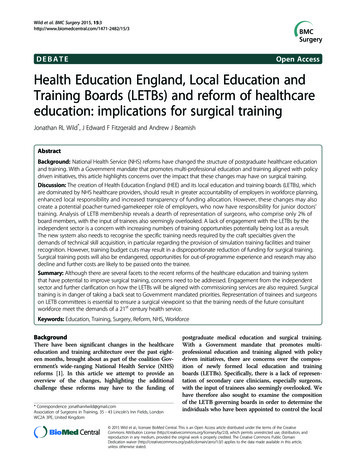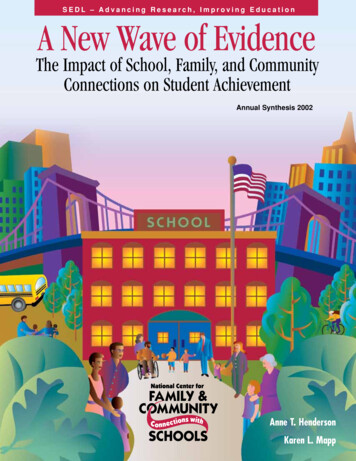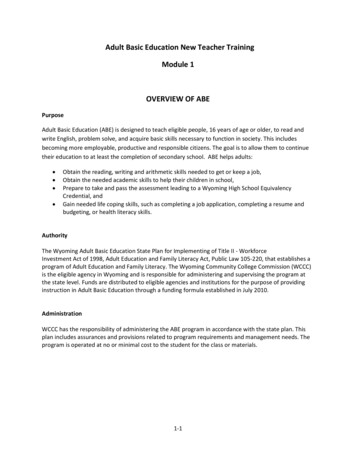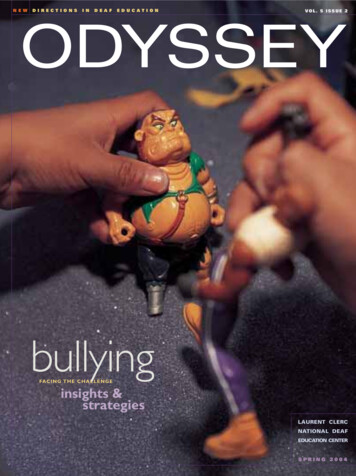
Transcription
N E WD I R E C T I O N SI ND E A FE D U C AT I O NVOL. 5 ISSUE 2ODYSSEYbullyingFACING THE CHALLENGEinsights &strategiesLAURENT CLERCNATIONAL DEAFEDUCATION CENTERSPRING 2004
GURCGALLAUDET UNIVERSITY REGIONAL CENTERSThe GURCs offer extension courses, training workshops, and technicalassistance to address the educational, transition, and professionaldevelopment needs of deaf and hard of hearing people from birth throughadulthood, their families, and the professionals who work with them.“The GURCs bring theresources of Gallaudetto my door!”NortheastNorthern EssexCommunity CollegeWestOhlone CollegeMid-AtlanticGallaudet UniversityLaurent ClercNational DeafEducation CenterPacificKapi’olaniCommunity CollegeMidwestJohnson CountyCommunity CollegeSoutheastFlagler CollegeFOR MORE INFORMATIONNORTHEAST REGIONSOUTHEAST REGIONWESTERN REGION(Connecticut, Maine, Massachusetts, NewHampshire, New York, Rhode Island,Vermont)(Alabama, Florida, Georgia, Kentucky,Louisiana, Mississippi, NorthCarolina, South Carolina, Tennessee)(Alaska, Arizona, California, Colorado, Idaho,Montana, Nevada, New Mexico, Oregon, Utah,Washington, Wyoming)Flagler CollegeE-mail: GRCFlagler@aol.comPhone: 904-819-6216 (Voice)904-829-2424 (TTY)Web: www.flagler.edu/about f/gallaudet.htmlOhlone CollegeE-mail: gurc.ohlone@gallaudet.eduPhone: 510-659-6268 (Voice/TTY)Web: http://www.ohlone.edu/instr/gallaudetNorthern EssexCommunity CollegeE-mail: gurc.necc@gallaudet.eduPhone: 978-556-3701 (Voice/TTY)Web: www.necc.mass.edu/gallaudetMID-ATLANTIC REGION(Delaware, District of Columbia, Maryland,New Jersey, Pennsylvania,Virginia, West Virginia,Puerto Rico, U.S. Virgin Islands)Laurent Clerc National Deaf Education CenterOffice of Training and ProfessionalDevelopmentE-mail: training.clerccenter@gallaudet.eduPhone: 202-651-5855 (Voice/TTY)Web: IFIC REGIONMIDWEST REGION(Arkansas, Illinois, Indiana, Iowa, Kansas,Michigan, Minnesota, Missouri, Nebraska,North Dakota, Ohio, Oklahoma, South Dakota,Texas, Wisconsin)Johnson County Community CollegeE-mail: gurc.jccc@gallaudet.eduVoice/TTY: 913-469-3872Web: http://web.jccc.net/academic/gurc(Hawaii, Guam, American Samoa, theCommonwealth of the Northern MarianaIslands)Kapi'olani Community CollegeE-mail: gurc.kcc@gallaudet.eduPhone: 808-734-9210 (Voice/TTY)Web: www.kcc.hawaii.edu
LETTER FROM THE DEANWhen many of us were students, we knew of the school bully—asingle student. At present, however, the phenomenon of studentbullying—and often the number of bullies per school—hasgrown, and educators and families are deeply concerned. Theissue is compounded by the fact that students many times donot report incidences of bullying to their teachers, counselors, orfamilies, choosing instead to endure beingbullied in silence and shame. There areindications that the consequences ofbullying can be long lasting and profound,ranging from suicidal depression to theshocking events at Columbine High Schoolfive years ago. This issue is of such concernthat many schools have taped a recentepisode of CBS’s “Without a Trace,” inwhich a student was bullied and ultimatelysaved from hanging himself in the nick oftime, and are showing it to students to prompt discussion.With this issue of Odyssey, we hope to encourage educators,counselors, and administrators to develop preventative strategiesand plans for intervention. William McCrone, a professor ofcounseling at Gallaudet University, cites the steps in developingsuch a plan; in addition, he notes the conflicting messages in ourculture that sometimes encourage respect, acceptance, and evenadmiration for bullies and bullying! Michael Harvey, apsychologist from Massachusetts, addresses the larger contextand asks how we can help students confront evil—from everydayunnecessary slights to the inexplicable horror of terrorism. BethBetman, a KDES social worker, describes how working withsandtrays can be especially helpful to children. Peter Steyger, aresearcher who grew up in England, draws on his personalexperience to observe how denial of one’s deaf identity canexacerbate bullying. Coletta Fidler, a counselor at MSSD, notesthat beginning each year with workshops on bullying is animportant step in a comprehensive plan for preventing bullying.Jennifer Tresh, from the National Deaf Academy in Florida,advises families on how to engage their children in conversationto ensure that if they are bullied, they will be able to talk aboutit. Claire Bugen and Steve Baldwin announce the release of theTexas School for the Deaf’s production of A Shadow’s Resolve, avideotape for schools to help prevent bullying.As educators, we must promote the qualities of citizenship,responsibility, and respect for one another. Whatever schools do,we must take action to ensure that students are safe and thatthey are provided with the necessary tools to ensure a safer, moreresponsible, and humane world.—Katherine A. Jankowski, Ph.D., DeanLaurent Clerc National Deaf Education CenterGallaudet UniversitySPRING 2004On the cover: Bullying may be explored through the use of sand andiconic figures. Photo by John Consoli.ODYSSEYBullying in SchoolsTaking Preventive MeasuresI. King Jordan, PresidentJane K. Fernandes, ProvostKatherine A. Jankowski, DeanMargaret Hallau, Director, National Outreach,Research, and Evaluation NetworkCathryn Carroll, EditorCathryn.Carroll@gallaudet.eduMary Ellen Carew, Contributing Editor,Mary.Carew@gallaudet.eduSusan Flanigan, Coordinator, Marketing andPublic Relations, Susan.Flanigan@gallaudet.eduCatherine Valcourt-Pearce, Production EditorTimothy Worthylake, Circulation, Timothy.Worthylake@gallaudet.eduJohn Consoli, Image Impact Design & Photography, Inc.O DY S S E Y EDITORIAL REVIEW BOARDSandra AmmonsOhlone CollegeFremont, CaliforniaSanremi LaRue-AtuonahGallaudet UniversityWashington, D.C.Gerard BuckleyNational TechnicalInstitute for the DeafRochester, New YorkFred MangrubangGallaudet UniversityWashington, D.C.Becky GoodwinKansas School for the DeafOlathe, KansasCynthia IngrahamHelen Keller NationalCenter for Deaf-BlindYouths and AdultsRiverdale, MarylandFreeman KingUtah State UniversityLogan, UtahSusan MatherGallaudet UniversityWashington, D.C.Margery S. MillerGallaudet UniversityWashington, D.C.David SchleperLaurent Clerc NationalDeaf Education CenterGallaudet UniversityWashington, D.C.Peter SchragleNational TechnicalInstitute for the DeafRochester, New YorkLuanne WardKansas School for the DeafOlathe, KansasKathleen WardenUniversity of TennesseeKnoxville, TennesseeJanet WeinstockLaurent Clerc NationalDeaf Education CenterGallaudet UniversityWashington, D.C.NATIONAL MISSION ADVISORY PANELDianne BrooksNational Technical Institutefor the DeafRochester, New YorkSandra FisherPhoenix Day Schoolfor the DeafPhoenix, ArizonaRonald LanierDepartment for the Deafand Hard of HearingRichmond, VirginiaRoberta CordanoUniversity of MinnesotaMinneapolis, MinnesotaTom HolcombOhlone CollegeFremont, CaliforniaRicardo LopezVSA ArtsWashington, D.C.Kim CorwinNew Mexico Schoolfor the DeafSanta Fe, New MexicoJana JonesDirector ofSpecial EducationBoise, IdahoFran ParottaUnited States Departmentof EducationWashington, D.C.Sheryl EmeryDeaf Access CenterSouthfield, MichiganMei KennedyCenter for AppliedScience TechnologyWakefield, MassachusettsDiane Victoria PerkinsBaltimore County PublicSchoolsBaltimore, MarylandHenry (Hank) KloppingCalifornia Schoolfor the DeafFremont, CaliforniaLinda RaymondClark County School DistrictLas Vegas, NevadaJan-Marie FernandezMantua ElementaryFairfax, VirginiaJoan ForneyIllinois School for the DeafJacksonville, IllinoisPublished articles are the personal expressions of their authors and do notnecessarily represent the views of Gallaudet University. Copyright 2004 byGallaudet University Laurent Clerc National Deaf Education Center. TheClerc Center includes Kendall Demonstration Elementary School, the ModelSecondary School for the Deaf, and units that work with schools and programsthroughout the country. All rights reserved.Odyssey is published two times a year by the Laurent Clerc National DeafEducation Center, Gallaudet University, 800 Florida Avenue, NE, Washington, DC20002-3695. Non-profit organization U.S. postage paid. Odyssey is distributedfree of charge to members of the Laurent Clerc National Deaf Education Centermailing list. To join the list, contact 800-526-9105 or 202-651-5340 (V/TTY); Fax:202-651-5708; Website: http://clerccenter.gallaudet.edu.The activities reported in this publication were supported by federal funding. Publication of theseactivities shall not imply approval or acceptance by the U.S. Department of Education of thefindings, conclusions, or recommendations herein. Gallaudet University is an equal opportunityemployer/educational institution and does not discriminate on the basis of race, color, sex, nationalorigin, religion, age, hearing status, disability, covered veteran status, marital status, personalappearance, sexual orientation, family responsibilities, matriculation, political affiliation, source ofincome, place of business or residence, pregnancy, childbirth, or any other unlawful basis.ODYSSEY1
10ENCOUNTERING ORDINARY EVIL:HELP CHILDREN MANAGEBy Michael A. HarveyFEATURES16USING SANDTRAY THERAPYWITH DEAF CHILDRENBy Beth Gwinn Betman4SCHOOL BULLYING—A PROBLEM FOR DEAF ANDHARD OF HEARING STUDENTS?By William P. McCrone22A RESEARCHER LOOKS BACKON BULLYINGFirst PersonBy Peter S. SteygerPERSPECTIVES AROUND THE COUNTRY28 GO CLASS GOUsing Dr. SeussBy Tamby AllmanOdyssey extends its thanks to the teacher and student models from theModel Secondary School for the Deaf and Kendall DemonstrationElementary School who helped us with the photographs for this issue:Merime Ahmed, Dwight Alston, Johana Cruz, Cierra Cotton, Megan George,Kimber Holmes, Cristian Medrano, Tayla Newman, Emmanuel Njoku,David Parham, Stacey Pedersen, Natacha Pericles, Wally Emul-Moore, TimMartin, Billy Shields, Yang So, Brennan Terhune-Cotter, Shannon Thornhill2ODYSSEYSPRING 2004
D I R E C T I O N SV O L . 5 ,24I S S U EI ND E A F2BULLYING: A SCHOOLE D U C A T I O NS P R I N G2 0 0 4NEWSRESPONDSBy ColettaFidler37 National Essay Contest Winner Selected38 Clerc Center Prepares Students for the Job39 On-line OT/PT Deaf Discussion39 Ohio Students Make Anti-Bullying Video39 Clerc Center Offers Summer Sports Camp39 Performing Arts: Hall of Fame OpensBy Susan M. Flanigan39 Malz? Who?By Terrylene41 KDES Student Wins Art Competition41 Expo Draws a Crowd32By Rosalinda RicasaFAMILY FUN NIGHT:WHERE STORIES42 E X T E N S I O N C O U R S E SCOME ALIVEBy Heather M. Waldner43 Catalog Goes OnlineBy Jennifer Hinger44 MSSD Launches Honors Program44 Audiologist & Teacher Win RecognitionBy Susan M. Flanigan45 N E W M A T E R I A L“Bully” Video from Texas SchoolBy Claire Bugen and Steve BaldwinIN EVERY ISSUE34IN THE FACEOF FORCEHelping Deaf ChildrenCopeBy Jennifer Tresh46 R E V I E WTapes and Manuals for New InterpretersBy Jeff Hardison46 R E V I E WListen with the HeartBy Cynthia J. Plue47 R E V I E WODYSSEYN E WASL Video Dictionary on CDBy Arlene B. Kelly48 T R A I N I N G O P P O R T U N I T I E SLAURENT CLERCNATIONAL DEAFEDUCATION CENTER50 C A L E N D A RSPRING 2004ODYSSEY3
schoolbullyinga problem fordeaf and hard ofhearing students?I N S I G H T S & S T R AT E G I E SBy William P. McCroneIf we are to have peace in the world, we have to start with the children. GandhiLouis, a slender, bright, 11-year-old black deaf residential school student withmild cerebral palsy, has fallen behind in his personal hygiene and his classroomwork because older deaf boys in his dorm physically and sexually taunt him whenhe is trying to sleep and when he uses the bathroom or shower of the dormitory.Spending money, clothes, and gifts from his parents have been regularly stolen.Louis’s tearful complaints have been brushed aside by a houseparent who toldLouis “not to be a baby.”Amy, a 16-year-old white deaf student with a cochlear implant, attended a largemainstream school where she was teased by hearing “sorority sisters” on theschool bus and through on-line instant messaging about her weight, braces,cochlear implant, sign language, and efforts to read lips. Amy frequently told hermother she was too ill to go to school. After a physical altercation in the cafeteriawith the hearing girls who had been teasing her, Amy, working through theclassroom interpreter, told the itinerant, part-time hearing school counselor thatshe uses marijuana and alcohol to deal with the stress of the bullying by thehearing girls and that she often thinks about suicide.Mohammed, an artistic hard of hearing 15-year-old Iranian American studentin a small, rural mainstream program, found that he socialized mostly withhearing female students because the hearing male students taunted him aboutbeing Muslim, hard of hearing, and homosexual. A teacher confrontedMohammed when she saw a box cutter knife in Mohammed’s backpack.Mohammed told the teacher he would use the knife against the school bullies ifnecessary. The teacher reported Mohammed’s weapon possession, which resultedin an Individualized Education Program disciplinary suspension. Mohammed’sparents are exploring home schooling.Photography by John T. Consoli4ODYSSEY
William P. McCrone,Ed.D., J.D., is a professorof counseling and formerdean of the School ofEducation and HumanServices at GallaudetUniversity in Washington,D.C. He was a legislativefellow to U.S. Senator TomHarkin, Chief Senatesponsor of the Americanswith Disabilities Act.Left: Bullying canhappen at any age, but itpeaks in middle schooland junior high school.ODYSSEY5
withdrawal, and long-term victim statusidentification (Batsche & Knoff, 1994;Olweus, 1993). Occasionally bullyingresults in murder. The suicide note left byEric Harris, one of the two attackers atColumbine High School in Littleton,Colorado, said: “Your children who haveridiculed me, who have chosen not toaccept me, who have treated me like I amnot worth their time, are dead.”Approximately 50 percent of boys whobully and 30 percent of girls who bully, aswell as 36 percent of boys and 15 percentof girls who have been bullied, carryweapons (Nansel, Overpeck, Haynie,Ruan, & Scheidt, 2003).The names have been changed but,with the exception of Mohammed whosestory can be checked out athttp://www.wrights law.com/info/discipl.suspend. crabtree.htm, each ofthese incidents comes from my files. Thebullying of deaf and hard of hearingstudents is surely at least as common asbullying among hearing students. Olweus(1993) found that 15 percent of studentsare either bullied regularly or are theinitiators of bullying behavior. ANickelodeon/Kaiser Family Foundationsurvey (2001) of 8- to 15-year-oldstudents found that “teasing andbullying” tops the list of school problemsidentified by these students. Thesestudents ranked teasing and bullying as abigger problem than “alcohol and drugs”or “pressure to have sex.”Bullies of deaf and hard of hearingstudents can be deaf, hard of hearing, orhearing. For some resilient students,incidents of bullying pass without lastingpsychological damage. But for otherstudents, bullying results in lifelongemotional damage and/or attempts,sometimes successful, at suicide. Studiesshow that students who are chronicallyvictimized by bullies are at increased riskfor depression, schizophrenia, self-conceptproblems, anxiety disorders, social6ODYSSEYDefinitions and ExplorationsWhat is bullying? Are deaf and hard ofhearing students particularly vulnerable tobullying? What motivates hearing and deafbullies to bully deaf and hard of hearingstudents? What resources are available to helpparents and educators prevent bullying inschools for deaf and hard of hearing students?Bullying is an ongoing method ofmistreating, dominating, hurting,frightening, and/or browbeating anotherperson by an individual or group. Bulliesuse physical, verbal, and psychologicalmethods to humiliate, embarrass, andoverpower others (Fried & Fried, 1996).Bullying by boys and girls can happen atany age, but it peaks in the middleschool/junior high school years(Bosworth, Espelage, & Simon, 1999;Harris & Petrie, 2002; Aber, Brown, &Jones, 2003). Ironically, this is the sameperiod when male testosterone levels,drug and alcohol abuse experimentation,sexual identity struggles, and teensuicide rates take off (McCrone, 2003).Bullying can take many forms—sexualharassment, extortion, physical abuse,racist behavior, teasing, pressuring,name-calling, social isolation, lyingabout and/or stealing from the victim.An Archives of Pediatrics and AdolescentMedicine study (Nansel et al., 2003) of15,000 students in grades six to tensuggests that school bullying should notbe considered a normal part of growingup, but as a risk factor for more extremeviolence in the future by both the bullyand the victim of the bullying.Approximately 60 percent of childrencharacterized as bullies in sixth throughninth grade had at least one criminalconviction by age 24 (Olweus, 1993).A Culture of Mixed MessagesDo we send children mixed messages aboutbullying? Is it possible that deaf and hearingyouth are seeing and learning far more probully messages in our culture than anti-bullymessages? What message does the “win at allcost” junior varsity coach send to studentathletes when he or she encourages and rewardsdefensive players for twist tackling the knees ofopposing quarterbacks? What are students tothink about out of control parents who assaultreferees at Little League and club hockeygames?Children do not live and learn in avacuum. How many of us have seen adultsdriving cars with bumper stickers that say“My kid beat up your honor roll student!”How many deaf and hearing children haveseen their parents engaged in “road rage”incidents? Bullying dominates many ofSPRING 2004
school girls by bullies? An argument canbe made that our culture and our mediaflood children—deaf, hard of hearing,and hearing—with pro-bully messagesthat subvert civility. Unfortunately,many families and school personnelsimply view bullying as a “rite ofpassage.” Children are told to “suck itup,” as if cruel pecking orders are agiven in life.the most popular TV cartoon and actionprograms (Klopfer, et al., 2002).Bullying is a common theme in WorldWrestling Federation programs thathearing, hard of hearing, and deafchildren like to watch on TV.The best-selling video games, “GrandTheft Auto” and “Hitman,” containpervasive bullying. Many parents inIllinois told the school that the hazingthat sent dozens of younger sororitypledges to the emergency room was notthe school’s business and some parentssued to be sure that their daughters—who had bullied the pledges to the pointthat they had to go to the hospital—would graduate on time (Walsh, 2003).Kip Kinkel, a troubled Oregonstudent in counseling because ofemotional problems and relatedbullying, murdered four peopleand tried to kill 25 more atThurston High School withguns his father, a teacher, hadbought for him for update).A music video by rapperformer 50 Cent that is seenfrequently on after-school MTVshows the sexist performerdominating near-nude women so hecan qualify as a pimp before a “pimpcouncil.” What might this have to dowith the sexual harassment of middleSPRING 2004Bullying and Deaf and Hardof Hearing StudentsHow many academically unsuccessful deafstudents have been the victims of bullying byhearing students and by more powerful deafstudents? Are the deaf or hearing bulliesacting out the prejudices of their families?According to research by John Hooverand Ronald Oliver (1996), “not fittingin” is the most common characteristic ofchildren who are bullied by their peers.Espelage, Asidao, and Vion (1999) foundthat students who are physicallydifferent and those who are perceived tobe “not as good at things as everyoneelse is” are more likely to be victimizedby bullies. The academic failure andschool dropout rates of deaf and hard ofhearing child
counselors, and administrators to develop preventative strategies and plans for intervention. William McCrone, a professor of counseling at Gallaudet University, cites the steps in developing such a plan; in addition, he notes the conflictin
